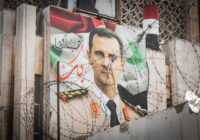The only sensible solution to the Syrian crisis is a quantum one in which Bashar al-Assad is simultaneously there and not there.
In medieval Europe, the king had two bodies. He sat on his throne in his own personal body, which suffered from the same sicknesses and infirmities that afflict all corporeal beings. But he also possessed a second body, the body politic, which represented the entire realm. The king served as “head of state,” a phrase that harkens back to this peculiar political theology. After the death of his own physical body, the king’s second body passed on to his successor, ideally his male offspring.
Syrian President Bashar al-Assad also has two bodies, and he’s worried about the fate of both of them.
The Syrian body politic is in the process of slow-motion dismemberment, for the head of state has lost quite a few of his extremities. Yet Assad is clinging to power in this shrunken entity, fearful of what might happen to his physical body—and those of his family and colleagues—if he should leave power, voluntarily or involuntarily. Images of the end days of Saddam Hussein (hanged) and Muammar Gadhafi (beaten, sodomized with a bayonet and shot to death) are surely uppermost in his mind. Prison, exile and answering charges in front of the International Criminal Court are only slightly less palatable scenarios.
The negotiations that took place on October 30 in Vienna over the fate of Syria are the latest attempt to resolve a conflict that has lasted more than four years, left over 250,000 people dead and displaced 11 million more. The diplomats are trying to come up with a compromise to transform Syria’s body politic. But the major sticking point is the actual body of Bashar al-Assad.
Some countries want Assad to stay. Some countries want him to go. In the end, we might end up with what physicists call a superposition of states. Call it Schrodinger’s Assad. The only sensible solution to the Syrian crisis is a quantum one in which the human-rights-abusing president is simultaneously there and not there.
Vacillation in Vienna
Diplomats from 17 countries, the European Union and the United Nations (UN) descended on Vienna on October 30. They were focused on resolving the conflict in Syria, but not ending the war. This might seem like a contradiction in terms. It’s also what has made the situation in Syria so monstrously difficult to address.
In their final communiqué, the parties agreed that “it is imperative to accelerate all diplomatic efforts to end the war.” But at the same time, they agreed that the Islamic State “must be defeated.” And they were not talking about defeating the Islamic State through some soft power tactic like releasing videos that question the leadership’s virility or piety. “Degrading” the Islamic State means bombing it out of existence.
And the assembled diplomats were not just worried about the Islamic State. They agreed to defeat “other terrorist groups, as designated by the U.N. Security Council, and further, as agreed by the participants.” Given that the “terrorist” label has been used to describe a large variety of actors in Syria—Russia and Turkey, for instance, have been bombing groups that the United States has been supplying—this particular clause in the communiqué doesn’t clarify who exactly is part of the problem and who is part of the solution.
Meanwhile, as the negotiators in Vienna were either hashing things out or just making a hash of things, many of their governments were actually ratcheting up the conflict. On the very day of the conference, the Obama administration announced that it was dispatching its first troops to Syria—a contingent of a few dozen Special Operations forces. The day before the conference, both the Syrian and Russian air forces conducted significant bombardments.
Given such mixed messages, the background music to the Vienna negotiations was not a comforting waltz, but the immortal 1966 Fugs song Kill For Peace with its catchy lyrics: “Kill, kill, kill for peace/Kill, kill, kill for peace/Near or middle or very far east/Far or near or very middle east.”
Then there’s the question of the territorial integrity of Syria. “Syria’s unity, independence, territorial integrity, and secular character are fundamental,” the communiqué states. That all sounds nice. But where does that put the Syrian Kurds, who are bent on establishing their own autonomous region in the north and are the recipients of US largesse? And at least some of the forces receiving weaponry from the United States (and certainly from Saudi Arabia) are not committed to a secular future for Syria. Ditto some of Iran’s friends on the ground.
Indeed, the dynamic established in Syria by the contending parties and their backers suggests a very Iraq-like future for the country, with a Kurdish-Sunni-Shia cleavage destroying any hopes of territorial integrity.
Finally, the negotiators made a nod in the direction of self-determination. “This political process will be Syrian led and Syrian owned, and the Syrian people will decide the future of Syria,” the communiqué reads. And yet, there was not a single Syrian at the table in Vienna. This was no oversight. It simply speaks to the utter lack of consensus over who has the moral authority to speak for Syrians today.
There is no mention of Bashar al-Assad in the final communiqué. But his presence (and potential absence) looms over any discussion of Syria’s future.
Winners and Losers
The US has long followed the “great man” theory of geopolitics in which leaders, benign or malign, are what matter. The United States practices foreign policy as if it were playing the market: picking winners and losers, hedging bets, engaging in the worst kind of speculation and even indulging in some insider trading.
The “winners” are people like Iraqi Prime Minister Haider al-Abadi, who is supposed to be tying his country back together but in fact has done almost as much as his predecessor to split it apart. Past winners have included the shah of Iran, Egypt’s Hosni Mubarak and (briefly) Saddam Hussein.
The losers are even easier to identify: Osama bin Laden, Saddam Hussein (again) and North Korea’s Kim Jong Eun. Just as the winners are expected to do our bidding and achieve quick results, the losers are expected to herald a new era of prosperity through their political or physical annihilation.
And so it is with Assad as well. The Obama administration has an almost mystical belief that the removal of the Syrian president will magically make Syria whole once again. In other words, Washington has the same kind of faith in the body of the Syrian leader as the medieval community had in the holy king. The removal of Assad’s body, a political tumor, will somehow heal the Syrian body politic, as if the two were congenitally connected.
But the US doesn’t have any replacement at the ready. After all, it’s not clear-cut who’s doing what on the ground in Syria. UN Special Envoy Staffan de Mistura has confessed that he is dealing in Syria with “230 different entities, groups, and the government.” The nearest thing to a government in exile—the Syrian National Council—has only one demand: the removal of Assad. Like the United States, it doesn’t have much of a plan for what to do in his stead. That’s not because the creation of plans is particularly difficult. Rather, how do you implement a plan when you have to get some semblance of consensus among 230 different entities, many of whom would much rather slit each other’s throats than hammer out political, economic or social compromises?
Bashar al-Assad is not a charismatic figure. Nor does he maintain legitimacy through the exercise of policymaking brilliance. He’s a 3F kind of guy: he rules by force, fealty and fear.
In many ways, the Assad clan has reproduced a medieval system of authority. His father, Hafez al-Assad, started out embracing a version of Baathism—an amalgam of Syrian nationalism, pan-Arabism and quasi-socialism—but gradually boiled down this ideology into the “Assadism” of an unquestioned leader, a personality cult and a hereditary dynasty. The remnants of Assadism command the loyalties of three overlapping constituencies: tribe (around 2 million Alawites), party (the 1.2 million members of the Baath party) and patronage (government officials plus 250,000 in the Syrian army, including reservists).
It’s of course conceivable that all of these people will switch their loyalties to another representative figure. But that doesn’t appear to be in the offing.
A Quantum Compromise
And so we return to the Schrodinger solution.
According to quantum theory, a particle can exist in two different states at the same time. Physicist Erwin Schrodinger was uncomfortable with this superposition, so he devised a thought experiment that involved a cat in a box with some radioactive material and poison gas. The intricacies of this scenario aside, Schrodinger created his infamous cat to translate indeterminacy at a micro level into absurdity at a macro level (i.e. a cat that is both dead and alive at the same time).
We are in a similar agony of macro-level uncertainty when it comes to Syria. How can we simultaneously oust Assad and defeat the Islamic State? How can we simultaneously respect the territorial integrity of Syria and support forces working to break it apart? How can we put the political process in the hands of Syrians and not invite a single one to the negotiating table? These paradoxes, as Schrodinger might have argued, reflect an underlying incoherence in our theories about Syria.
And yet when it comes to a morass like Syria, it is only fitting that we fight paradox with paradox. The only sensible approach is to compromise on Assad by devising a political solution that keeps the head of state in power (nominally) and yet deprives him of power (substantively). Inside the box of Syria, Assad would be both politically dead and politically alive at the same time. It’s all a matter of perception, of course. Assad may well believe that he is the head of state even though everyone else treats him as a figurehead. In this way, compromises and political transitions are made.
In Vienna, the negotiators thought an end was in sight for Syria. Without more substantial compromise, however, it will be the country, not the conflict, that will wink out of existence—the body politic and the body Assad both consumed in the flames of a civil war, a sectarian war and a proxy war all combining into one huge conflagration.
*[This article was originally published by FPIF.]
The views expressed in this article are the author’s own and do not necessarily reflect Fair Observer’s editorial policy.
Photo Credit: Volodymyr Borodin / Olivier Borgognon / Shutterstock.com / Surian Soosay
 We bring you perspectives from around the world. Help us to inform and educate. Your donation is tax-deductible. Join over 400 people to become a donor or you could choose to be a sponsor.
We bring you perspectives from around the world. Help us to inform and educate. Your donation is tax-deductible. Join over 400 people to become a donor or you could choose to be a sponsor.
Support Fair Observer
We rely on your support for our independence, diversity and quality.
For more than 10 years, Fair Observer has been free, fair and independent. No billionaire owns us, no advertisers control us. We are a reader-supported nonprofit. Unlike many other publications, we keep our content free for readers regardless of where they live or whether they can afford to pay. We have no paywalls and no ads.
In the post-truth era of fake news, echo chambers and filter bubbles, we publish a plurality of perspectives from around the world. Anyone can publish with us, but everyone goes through a rigorous editorial process. So, you get fact-checked, well-reasoned content instead of noise.
We publish 2,500+ voices from 90+ countries. We also conduct education and training programs
on subjects ranging from digital media and journalism to writing and critical thinking. This
doesn’t come cheap. Servers, editors, trainers and web developers cost
money.
Please consider supporting us on a regular basis as a recurring donor or a
sustaining member.
Will you support FO’s journalism?
We rely on your support for our independence, diversity and quality.








